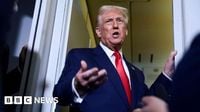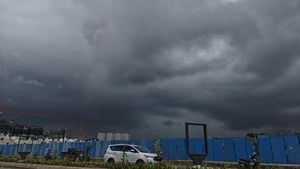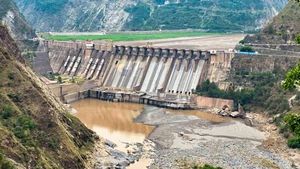America’s nuclear arsenal, long seen as the bedrock of its global power, is suddenly at the center of a heated debate. President Donald Trump’s recent announcement that the United States will resume nuclear weapons testing has sent shockwaves through Washington and capitals around the world. The move, pitched as a necessary step to keep up with rivals like Russia and China, has ignited fierce discussions over national security, international stability, and the very future of arms control.
On October 30, 2025, President Trump took to his social media platform, Truth Social, to declare, “Because of other countries testing programs, I have instructed the Department of War to start testing our Nuclear Weapons on an equal basis. That process will begin immediately.” The timing was no accident—Trump made the post just before a high-profile meeting with Chinese President Xi Jinping, underscoring the geopolitical stakes.
Yet, as reported by BBC and The Economic Times, the details of Trump’s plan remain murky. The White House has not clarified whether “testing” means detonating nuclear warheads—a practice the U.S. abandoned in 1992—or simply ramping up tests of delivery systems such as intercontinental ballistic missiles. The ambiguity has only fueled anxiety among allies and adversaries alike.
Why now? The answer, according to multiple sources including The Wall Street Journal and defense analysts, lies in the aging state of America’s nuclear arsenal. Many warheads and delivery systems date back to the 1960s through the 1980s, and a Pentagon review nearly a decade ago revealed glaring issues: technicians responsible for maintaining 450 nuclear missiles had access to only one specialized wrench, which they shipped between bases via FedEx. Senators Roger Wicker and Deb Fischer wrote, “For more than 75 years, U.S. nuclear forces have underpinned American power and kept our homeland safe... But critical updates to our arsenal are underfunded and behind schedule. Congress and the White House must act quickly to solve these problems and prevent more from emerging.”
Modernization efforts are underway, but experts warn they may not be complete until the 2040s—a timeline that could leave the U.S. vulnerable as rivals move ahead. Robert Peters of the Heritage Foundation cautioned, “By the time modernisation is complete in the 2040s, the arsenal may still fall short of meeting the strategic realities of the 21st century.” The U.S. faces not just Russia and China, but also a growing list of nuclear-capable adversaries. North Korea continues to develop increasingly sophisticated missiles and warheads, Pakistan is reportedly building intercontinental ballistic missiles capable of reaching the American homeland, and Iran is now considered a nuclear threshold state, with enough enriched uranium to produce several weapons within weeks.
Against this backdrop, Trump’s call for renewed testing is seen by some as a technical necessity—a way to ensure that America’s deterrent remains credible. Treasury Secretary Scott Bessent has argued that testing and renewed development could help the U.S. “catch up” with China’s rapid advances, echoing fears that America’s edge is slipping away. As Peters put it, “It may be necessary for some president, whether it's Donald Trump or whomever, to test nuclear weapons as a demonstration of credibility.”
But critics, both at home and abroad, are sounding alarms about the risks. Daryl Kimball, executive director of the Arms Control Association, warned that resuming nuclear testing would be “a mistake of historic international security proportions.” According to Kimball, the risk of nuclear conflict “has been steadily rising” over several years, and without new constraints, “we’re likely going to see an unconstrained, dangerous, three-way arms race between the US, Russia and then China in the coming years.”
The international response has been swift. Russia, which recently tested new delivery systems including a missile said to penetrate U.S. defenses and an underwater missile capable of striking the U.S. coast, stated through a Kremlin spokesman, “If someone departs from the moratorium, Russia will act accordingly.” China, meanwhile, urged the U.S. to honor its commitments under the Comprehensive Nuclear-Test-Ban Treaty—a pact both nations have signed but not ratified. The treaty, though not technically in force, has served as a de facto global ban on nuclear detonations since the 1990s. Only North Korea has violated this norm, conducting six tests since the end of the Cold War, the last in 2017.
Experts like Jamie Kwong of the Carnegie Endowment for International Peace see Trump’s move as a potential domino in a precarious moment. “We’re at a very concerning moment where the US, Russia and China are potentially entering this moment that could very well become an arms race,” Kwong told BBC. Darya Dolzikova of the Royal United Services Institute added that while Trump’s announcement may not dramatically change the landscape by itself, “there are other dynamics globally that have raised the risks of nuclear exchange and further proliferation of nuclear weapons to levels higher than they have been in decades.”
The world is already on edge due to a series of flashpoints involving nuclear powers. The war in Ukraine has seen Russian President Vladimir Putin openly threaten the use of nuclear weapons. Tensions between India and Pakistan flared in 2025, and Israel’s shadow conflict with Iran continues to stoke fears of proliferation in the Middle East. The last remaining U.S.-Russia treaty limiting deployed nuclear warheads is set to expire in February 2026, and experts warn that its lapse could remove the final guardrail preventing a new arms race.
Despite Trump’s claim that the U.S. has more nuclear weapons than any other country, the Stockholm International Peace Research Institute reports that Russia actually leads with 5,459 warheads, followed by the U.S. with 5,177, and China a distant third with 600. The U.S. currently relies on computer simulations and non-explosive methods to test its arsenal, and reactivating the Nevada test site for live detonations would take at least 36 months, according to Kimball.
There are also domestic hurdles. Any resumption of live testing would likely occur at the Nevada Test Site, now closer to the ever-expanding Las Vegas metropolitan area. Local opposition could be fierce, potentially fracturing Trump’s political base—especially with midterm elections looming. As columnist Andreas Kluth noted, “Nevadans and their Congressional delegation would kick up a huge fuss, possibly splintering the MAGA coalition just as the mid-term elections come due.”
The broader worry, as articulated by experts like Jeffrey Lewis of the Middlebury Institute, is that renewed testing could spark a global cascade. The U.S., having already amassed the most data from over a thousand tests, would gain little, but China, with its advanced computing power and relatively limited test data, could leap ahead. “China would ‘learn the most’ and advance asymmetrically,” Lewis explained. Worse, the normalization of testing could encourage more countries to seek nuclear capabilities, undermining decades of nonproliferation efforts.
The stakes could not be higher. As Rhys Crilley of the University of Glasgow put it, “If the new nuclear arms race hasn’t already begun, then we’re currently heading towards the starting line. I worry every day about the risks of a nuclear arms race and the increasing risk of nuclear war.”
In the end, Trump’s announcement has forced a reckoning with uncomfortable truths about America’s aging arsenal, the shifting balance of power, and the fragility of the global order. Whether or not the U.S. moves forward with live nuclear testing, the debate has laid bare the urgent need for renewed diplomacy, investment, and vigilance in a world where the nuclear threat is anything but a relic of the past.






